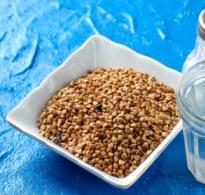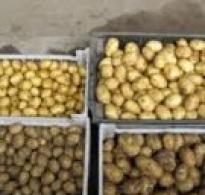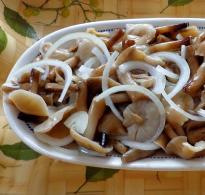How to cook a Korean dish pince-nez. Pyan-se
Step 1: prepare the flour.
Using a sieve, sift the flour directly into the middle bowl so that no flour lumps come across in the dough, and it turns out to be more airy and softer, due to oxygenation from the air.Step 2: prepare the yeast mixture.
 Pour the purified water into a small saucepan and set the container over low heat. Already literally through 4-6 minutes the water will become warm, and this is exactly what we need to knead the dough. Attention: if the water has reached a temperature higher 36 ° -38 ° C, just put the pan aside and give it time to cool down a little.
Pour the purified water into a small saucepan and set the container over low heat. Already literally through 4-6 minutes the water will become warm, and this is exactly what we need to knead the dough. Attention: if the water has reached a temperature higher 36 ° -38 ° C, just put the pan aside and give it time to cool down a little.
 So, after - turn off the burner, and add sugar to warm water and mix everything well with a tablespoon. After that, pour dry yeast into the container, and again gently stirring everything with the improvised inventory, dissolve the component in the liquid and then set it aside to brew for 10 minutes. Important: if the water temperature is higher than it should be, then the yeast may deteriorate and the pies simply will not work.
So, after - turn off the burner, and add sugar to warm water and mix everything well with a tablespoon. After that, pour dry yeast into the container, and again gently stirring everything with the improvised inventory, dissolve the component in the liquid and then set it aside to brew for 10 minutes. Important: if the water temperature is higher than it should be, then the yeast may deteriorate and the pies simply will not work. Step 3: prepare the dough.
 So, pour the infused yeast mixture into a deep bowl and add a pinch of salt there and, using a tablespoon, carefully add flour in small portions. Knead the dough for 7-10 minutes until it becomes dense and does not stop sticking to your hands. Attention: you can knead the dough with a tablespoon, and with a blender, and with your hands. In short, whoever is more comfortable. The main thing is that the dough turns out without flour lumps and has the correct consistency. Finally, add vegetable oil to the dough and knead the dough again. After - we form a ball from the dough and put it in a bowl, also pre-greased on all sides with vegetable oil. This must be done so that the dough does not become weathered and does not stick to the bottom and walls of the container. So, now we wrap a bowl of dough with cling film and set aside in a warm place to brew for 1 hour.
So, pour the infused yeast mixture into a deep bowl and add a pinch of salt there and, using a tablespoon, carefully add flour in small portions. Knead the dough for 7-10 minutes until it becomes dense and does not stop sticking to your hands. Attention: you can knead the dough with a tablespoon, and with a blender, and with your hands. In short, whoever is more comfortable. The main thing is that the dough turns out without flour lumps and has the correct consistency. Finally, add vegetable oil to the dough and knead the dough again. After - we form a ball from the dough and put it in a bowl, also pre-greased on all sides with vegetable oil. This must be done so that the dough does not become weathered and does not stick to the bottom and walls of the container. So, now we wrap a bowl of dough with cling film and set aside in a warm place to brew for 1 hour.
 During this period of time, the dough should increase 2 times. In the meantime, it is infused, let's prepare the filling for pyan-se.
During this period of time, the dough should increase 2 times. In the meantime, it is infused, let's prepare the filling for pyan-se. Step 4: prepare the cabbage.
 First of all, remove the top coarse leaves from the cabbage and then rinse the ingredient well under running water. We spread the vegetable on a cutting board and, using a knife, chop the cabbage. Transfer the chopped component to a free deep bowl, salt to taste and knead a little with your hands so that the cabbage releases a small amount of juice.
First of all, remove the top coarse leaves from the cabbage and then rinse the ingredient well under running water. We spread the vegetable on a cutting board and, using a knife, chop the cabbage. Transfer the chopped component to a free deep bowl, salt to taste and knead a little with your hands so that the cabbage releases a small amount of juice. Step 5: prepare the onion.
 Using a knife, peel the onion from the husk and then rinse the ingredient well under running warm water. We spread the vegetable on a cutting board and, using the same sharp improvised equipment, chop the onion into small squares, the size no more than 5 millimeters... Transfer the finely chopped onion to a clean medium bowl.
Using a knife, peel the onion from the husk and then rinse the ingredient well under running warm water. We spread the vegetable on a cutting board and, using the same sharp improvised equipment, chop the onion into small squares, the size no more than 5 millimeters... Transfer the finely chopped onion to a clean medium bowl. Step 6: prepare the garlic.
 Using a knife, peel the garlic from the husk and then lightly rinse the ingredient under running water. Then, put the cloves of garlic on a cutting board and, using the same sharp improvised inventory, finely chop the component. After - put the garlic in a bowl with chopped onion.
Using a knife, peel the garlic from the husk and then lightly rinse the ingredient under running water. Then, put the cloves of garlic on a cutting board and, using the same sharp improvised inventory, finely chop the component. After - put the garlic in a bowl with chopped onion. Step 7: prepare the minced meat.
 Put the minced pork and beef in a bowl with chopped onions and garlic, add black pepper to taste and mix all the ingredients thoroughly with a tablespoon until a homogeneous mass is formed. Attention: if you are using fresh frozen minced meat, then it must be removed from the freezer in advance and set aside to cool to room temperature. In no case should the meat component be defrosted in a microwave oven or under running hot water, as this can spoil the taste of the filling.
Put the minced pork and beef in a bowl with chopped onions and garlic, add black pepper to taste and mix all the ingredients thoroughly with a tablespoon until a homogeneous mass is formed. Attention: if you are using fresh frozen minced meat, then it must be removed from the freezer in advance and set aside to cool to room temperature. In no case should the meat component be defrosted in a microwave oven or under running hot water, as this can spoil the taste of the filling. Step 8: prepare the pyan-se filling.
 Put the shredded cabbage in the pan and set the container on a fire less than average. After the pan has warmed up well, and the cabbage at the bottom of the container starts to "sizzle", cover the pan tightly with a lid and simmer the cabbage filling for 10 minutes, from time to time removing the lid and stirring everything with a tablespoon. Attention: there is no need to add vegetable oil, since the cabbage should be stewed in its own juice. After the allotted time, turn off the burner, remove the lid from the pan and set the cabbage aside to cool slightly.
Put the shredded cabbage in the pan and set the container on a fire less than average. After the pan has warmed up well, and the cabbage at the bottom of the container starts to "sizzle", cover the pan tightly with a lid and simmer the cabbage filling for 10 minutes, from time to time removing the lid and stirring everything with a tablespoon. Attention: there is no need to add vegetable oil, since the cabbage should be stewed in its own juice. After the allotted time, turn off the burner, remove the lid from the pan and set the cabbage aside to cool slightly.
 Now add minced meat to the pan and mix everything well with a tablespoon until smooth. That's it, the filling is ready.
Now add minced meat to the pan and mix everything well with a tablespoon until smooth. That's it, the filling is ready. Step 8: preparing pyan-se.
 After the allotted time for the tincture of the dough has expired, knead it well again so that the resulting carbon dioxide comes out of the dough ingredient due to fermentation of the yeast. Put the dough on the kitchen table, crush with a little flour, and use a knife to cut the dough piece into small pieces. Attention: the pieces should be as large as you want the patties to be.
After the allotted time for the tincture of the dough has expired, knead it well again so that the resulting carbon dioxide comes out of the dough ingredient due to fermentation of the yeast. Put the dough on the kitchen table, crush with a little flour, and use a knife to cut the dough piece into small pieces. Attention: the pieces should be as large as you want the patties to be.
 After that, we form a ball from each piece with our hands. Using a rolling pin, roll each ball into a cake, approximately 8-10 mm... Put the filling in the center of each cake with a teaspoon.
After that, we form a ball from each piece with our hands. Using a rolling pin, roll each ball into a cake, approximately 8-10 mm... Put the filling in the center of each cake with a teaspoon.
 And now we begin to form pyan-se. The shape of these pies can be whatever you like more. You can make an oval pie by pinching the edges of the dough tightly with your fingers in the center of the dish, while you need to sort of pick up the seam, making it more grooved and beautiful, and not crushing it. Or, for example, you can make a pyan-se round. To do this, you need to collect the edges of the dough, like tying a bag to a knot. In this case, it is necessary in turn to bend the edges of the cake to the center, crushing the dough well with your fingers, so that during the cooking process our cake does not open and the filling does not fall into the container of the double boiler.
And now we begin to form pyan-se. The shape of these pies can be whatever you like more. You can make an oval pie by pinching the edges of the dough tightly with your fingers in the center of the dish, while you need to sort of pick up the seam, making it more grooved and beautiful, and not crushing it. Or, for example, you can make a pyan-se round. To do this, you need to collect the edges of the dough, like tying a bag to a knot. In this case, it is necessary in turn to bend the edges of the cake to the center, crushing the dough well with your fingers, so that during the cooking process our cake does not open and the filling does not fall into the container of the double boiler.
 As soon as all the pyan-se are formed, we spread the pies in portions in a double boiler or a mantool and cook them for 40 minutes. After the allotted time, using a slotted spoon or fork, we take out the pies from the container and put them on a serving dish.
As soon as all the pyan-se are formed, we spread the pies in portions in a double boiler or a mantool and cook them for 40 minutes. After the allotted time, using a slotted spoon or fork, we take out the pies from the container and put them on a serving dish. Step 9: serve pyan-se.
 While the pyan-se is still hot, it is best to serve them immediately after cooking. But you can treat guests with such pies along with sour cream, mayonnaise or any sauce of your choice.
While the pyan-se is still hot, it is best to serve them immediately after cooking. But you can treat guests with such pies along with sour cream, mayonnaise or any sauce of your choice.
 Pyan-se turns out to be very tasty, aromatic and with a juicy hearty filling. Good appetite!
Pyan-se turns out to be very tasty, aromatic and with a juicy hearty filling. Good appetite! - - If you want to cook pyan-se during Lent, then minced meat can be replaced with fried mushrooms.
- - In addition to such a spice as black ground pepper, you can add a little red ground pepper to the filling. But that's only if you like spicy food.
- - Instead of white cabbage, you can chop Chinese cabbage into the filling. Then pyan-se will be even more tender and fragrant.
- - If you did not have a special steamer or a mantool at your fingertips, do not be discouraged, as you can always purchase a double boiler-fan. Such dishes are very convenient and easy to use. To do this, fill an ordinary deep frying pan or cauldron with thick walls and a bottom with a small amount of water, put a double boiler-fan in the container and put pies on its surface. And so that the dish does not stick to the surface of the steamer, it can be greased with a small amount of vegetable oil using a pastry brush. After that, we put the container on a fire less than average, cover the frying pan or cauldron tightly with a lid and cook the pyan-se within the prescribed time.
My recipe is for "eat once", so the quantities are small. From this amount, we get 10 pyan-se, about 10x7 cm in size. Three adults have enough to eat, but no one likes to eat it. I absolutely do not claim the authenticity of the recipe, but in this form it has taken root with us for a long time and everyone likes it.
I use sliced pork, but you can use minced meat, whatever. I put out cabbage, because I do not like the smell of boiled cabbage. I also stew the meat, although I know that there are recipes with raw meat and raw cabbage, we didn’t go like that. If you use minced meat, then it is imperative to extinguish it, otherwise it will stick together into a lump during cooking. Well, I make two fillings, one standard - meat, cabbage, onions (this is for the family) and the second for myself, because I absolutely can't do cabbage - chicken, pumpkin and onion. In the filling, we have more meat in volume than cabbage, or about the same, although I met options and vice versa. By the way, if you take only pumpkin and onions for the filling, you will get a lean version of this dish. I cook in a double boiler, this amount just fits into 2 baskets of a Brown double boiler.
For the test:
- 300 g flour
- 1 tbsp vegetable oil,
- 1/2 tsp Sahara,
- 4 g dry yeast,
- 175 ml of water,
- 1/2 tsp salt.
Filling 1:
- pork - about 170 g,
- 1 small onion
- cabbage - about 100 g,
- garlic,
- vegetable oil,
- salt,
- pepper,
- favorite seasonings.
Filling 2:
- chicken fillet - about 120 g,
- pumpkin - about the same,
- 1/2 onion (add to taste)
- pepper,
- garlic,
- seasonings.
Cooking.
1. First, put the dough. In a bowl I breed 4 g of dry yeast (I have a Meal) in a small amount of warm water with 1/2 tsp. Sahara. I put it aside. Sift 300 g of flour into a separate bowl and set aside. I pour 175 ml of warm water with 1/2 teaspoon of salt into a bowl for the dough, pour over the loose yeast, add a tablespoon of vegetable oil and gradually add flour. The dough should be soft, but lag behind the hands. All the flour does not interfere at once. I knead the dough well, about 20 minutes, then grease the surface of the resulting kolobok with oil, put it in a cup (I also grease the cup with oil), tighten the cup with a film and put it in a warm place to approach. The dough should come up twice, each time increasing in volume by about 2 times. I knead it every time after lifting, adding flour. As a result, after the second ascent, almost all of the flour was gone.


2. Pork stuffing with cabbage. I cut the pork into small cubes. It is best to cut it when it is semi-frozen. Transfer to a bowl and leave to defrost. I cut fresh cabbage into small strips, salt it and “hammer” it strongly so that it becomes soft. I add pepper, paprika, (you can add a little soy sauce - I don't have it), crushed garlic and leave to marinate. Cabbage is its own, from the cellar, so it was no longer particularly juicy. I cut onions into small cubes. That's it, that's all for now. Let it stand. In the meantime, I'm doing the second stuffing.



3. Stuffing chicken breast with pumpkin. I also cut one chicken file (in an unfrozen state) into small cubes. Transfer to a bowl and set aside. Grate pumpkin (pumpkin in volume is about the same as breast). I cut onions into cubes. I add everything to a bowl to chicken, salt, pepper, add garlic and a little bit of seasoning for Korean carrots. This filling is ready.




4. Returning to the first filling. The cabbage has already been pickled, so you can bring it to the end. I put a frying pan on the comfort, pour in vegetable oil and fry the onion until transparent, then add the pork and fry quite a bit (5 minutes, no more), just so that the pork turns white, add garlic, seasonings and remove from heat. I transfer the contents to a bowl. And put the cabbage in the pan and fry it without adding oil, also quite a bit (3-4 minutes). I shift the cabbage to the meat and leave to cool. Everything, this filling is also ready.




5. Modeling pyan-se. I divide the dough in half, roll sausages from the halves and divide each into 5 parts. I make a cake from each part and roll it out to a thickness of ~ 5 mm. I roll out all the tortillas at once to distribute the filling evenly. I spread the filling on each cake and cover it with a pigtail. It is necessary to seal the pies very carefully so that they do not open during cooking. From my number of fillings, 6 pies with pork and 4 with chicken turned out (I covered them differently, so that they were different). There is no need to part with the pies.



6. Cooking. She greased the basket of the steamer with vegetable oil and put pian-se into it. It is necessary to add at intervals. They will increase in volume when cooked. In general, I have them in 5 pieces. I cook for a couple of 45 minutes. Immediately after the signal, you must not remove and open the lid !!! Otherwise, they will fall off. They have to stand for another ten minutes. If you are cooking in a mantool, then place a towel under the lid so that the liquid does not pour onto the pies. After the end of the time, remove the cooker from the comfort zone, but do not open the same 10 minutes. That's it, time has passed, we open the lid and carefully take out our pian-se. I immediately grease them with butter, serve them with sour cream, soy sauce and Korean carrots.



Well, she seems to have described everything. In fact, it is only described and read for a long time, but they are done quickly. Try it, enjoy it yourself and indulge your loved ones with delicious treats!
APPENDIX 1
You can knead the dough using a mixer (I have one from Soviet times, with a bunch of attachments, including for the dough). I usually knead with my hands, but today the body asked for help. Everything was mixed up perfectly. Then she warmed up the multicooker bowl and put the dough in there, closed the lid, the dough rose there beautifully and quickly. Somehow I missed this opportunity before, I really liked it, so I recommend it.
the recipe is the same as on the first page, only today the filling is completely pork and cabbage. Report:




APPENDIX 2
Here, I did it with meat and potatoes, only I left the potatoes raw. As a result, they turned out to be more or less juicy, but, of course, not the same as with cabbage! I did such things for the first time, the family approved, said that along with the “relatives”, pyan-se did these “misunderstandings” too. Ate with carrots and soy sauce, I ate with sour cream, I liked it. Well, as an alternative to those who cannot eat cabbage
Photo report:




Let's start with the test. Add the rest of the ingredients (eggs, salt, sugar, yeast and flour) to well-heated milk, knead the dough. Next, it is important to add vegetable oil and knead thoroughly (in my opinion, this is not easy to do - the oil just slides over the dough, so I had to tinker with it).
Leave in a warm place for an hour and a half, the volume should increase by 2-3 times. While waiting, you can prepare the filling.
To do this, mince the meat twice, adding 1 medium onion and 5 cloves of garlic. The filling in pyan-se must be very juicy, so cabbage and minced meat are taken in approximately equal parts, squeeze the cabbage and chop a little. Especially good for these pies.
If there is no sauerkraut or, for some reason, you want to use fresh cabbage, it must be finely chopped, salt and left for at least 1 hour, then squeeze out the released juice. So, mix the minced meat with cabbage, salt and pepper and add 4 tablespoons. vegetable oil. Knead the minced meat well.
Once the dough has come up, you can start sculpting. Take some dough, roll out a thick sausage on a floured surface, cut into equal pieces. 
Roll each piece into a neat ball, about 5-7 cm in diameter (for clarity, I put a chicken egg next to it). 
Now roll the ball with a rolling pin into a cake 4-5 mm thick. 
Put a lot of filling in the middle of the cake, do not regret it, otherwise after the dough rises, there will be little filling. 
Connect the edges with the herringbone technique to the middle of the product. 
Next, unfold the pyan-se and sculpt from the opposite edge to the middle. 
Make the rest of the patties. Leave for 15-20 minutes to grow a little. 
Steam the pyanse for 40 minutes. To check the readiness, press (pinch) with dry fingers, if it does not stick, then it is ready. 
Serve with adjika, or soy sauce, vinegar. Eat with your hands. 
Pigodi - minced meat steamed pies
Korean pies with steamed meat and cabbage, which are also called: pyan-syo, pegheses or pigody, I tried as a child in Yuzhno-Sakhalinsk. The impression from them was so strong that even after many years I still remembered the taste, the composition of the filling and the surprisingly white color of pian-se (then I could not understand: if pian-se is a pie, then why is it not rosy, but white like a dumpling ?!).
And just recently I decided to look for how pian-syo is prepared. It turned out that the recipe for steamed pies is simple both in composition and in the method of preparation. Especially in our age of electric steamers. The long-awaited Korean pies turned out to be very tasty, especially when eaten with hot sauce.
What is pyogody made of (pyang-syo)
for 20 pies
Yeast dough
- Flour - 800 g + 100 g for sprinkling;
- Warm water - (2 glasses);
- Sugar - 1 teaspoon;
- Salt - 1 teaspoon;
- Dry yeast - 1 teaspoon.
Filling of Korean pies
- Minced meat (better - pork and beef) or finely chopped meat - 300 g;
- White cabbage (you can take Chinese salad = Chinese cabbage) - 300 g;
- Onion - 1 head;
- Garlic - 2 cloves;
- Greens (dill, parsley, cilantro or basil) - to taste;
- Ground coriander - 0.5 teaspoon;
- Ground black pepper - 0.5 teaspoon;
- Salt to taste.
A little vegetable oil for lubricating the steamer.
The composition of the sauce for pigody (pian-syo, pegez)
- Soy sauce - 1/4 cup;
- Table vinegar 9% - 1 tablespoon;
- Sugar - 1 tablespoon;
- Ground black pepper - 0.5 teaspoon;
- Garlic - 2 cloves;
- Cilantro or other greens - a few twigs;
- Chili pepper (bitter red) - a little;
- Salt to taste, optional, salty soy sauce).
How to cook pyan-se (pyogody, pegues)
Make a dough for Korean pies
- Stir yeast and sugar in 0.5 cups of warm water (30-35 degrees C).
- As soon as the yeast comes to life and foam appears, combine the yeast with the rest of the water. Add salt. Introduce flour gradually. Knead the dough. We will get a dough.
- Cover the bowl / saucepan with a lid, then a towel (to keep warm). And put it in a warm place (usually, the warmest thing is in the kitchen near the ceiling, you can put it on the closet). Allow the dough to come up (should increase by 1.5-2 times).
- Knead the dough that has come up and let it rise again (do this 1-2 times). The finished dough will increase in volume at least 2 times from the original.
- After - sprinkle the table with flour, put the dough on it and knead it again (until it becomes smooth and shiny). If the dough sticks to your hands, add more flour (usually for pian-sho they take the dough stronger than for ordinary pies).
The time it takes to raise the dough on pian-sho depends on the type and quality of the yeast, and on how favorable (warm) conditions are in the kitchen for the dough. It takes about 2 hours to prepare the yeast dough for pian-sho.
Prepare the pigody filling (pyang-syo)
- Finely chop the meat (chop) or make minced meat from the meat. You can use good quality off-the-shelf minced meat.
- Chop the cabbage thinly and finely. Sprinkle with salt and squeeze with your hands (so that it softens and absorbs the salt). Usually, cabbage with hard and coarse leaves is sold in winter. Then it is better to replace it with Chinese cabbage (Chinese salad).
- Finely chop the onions. Pass the garlic through a press (you can grate or chop finely). Tear off the thick stems from the greens and finely chop the leaves.
- Combine minced meat, cabbage, herbs, onions, garlic, spices. Salt, stir well.
Blind the pigody (pyang-syo)
- Say the dough into a ball, then divide into 20 parts. Which are also rolled into balls. Flatten the balls into flat cakes (less than 0.5 cm thick). This is the basis of the yang-syo pie.
- Put 1 tablespoon of minced meat on each flat cake. First connect the middle of the pie, then pick up the edges. You should get a neat, sealed seam, and the pigody should take on an oval shape with rounded or pointed ends. If desired, it can be with curly tucks (for beauty).
Cook pyogody (pyang-se) in a double boiler
- Grease a bowl of a double boiler with vegetable oil. Put the pies with the seam downward at a distance from each other, because the pian-syo will increase in volume during cooking.
- Pour hot water into the lower bowl of the steamer (this will save time by skipping the water heating step). To cover with a lid. Cook pian-syo in a double boiler for 40 minutes.
How serve and store pyang-syo (pigody)
- Ready-made white Korean pies can be brushed with vegetable or butter. So they will shine beautifully.
- Pian-sho is best served with soy-based hot sauce. It will be delicious! Although, the pies are good on their own.
- Pian-syo (pigody) should be stored in a sealed container or tightly tied in a plastic bag.
Making pigogie sauce (pyang-sho)
- Chop the herbs and garlic. Combine all components of the sauce (except salt). Salt should only be tasted. If you understand that there is not enough salt to taste, salt it.
Bon Appetit!
Ready-made Korean-style steamed pies!
Cooking pigody - photo
What is the dough for white pies pian-syo (pigody) made of? The crumpled dough should grow up again Knead the finished dough on the table
The finished dough is rolled into a ball Divide the dough into 20 pieces, which we roll into balls. The composition of the filling of Korean pies pyan-se (pigody)
For the meat filling, you can take minced meat or finely chopped meat Pigody (pyang-se) Chopped garlic for the pigody filling Chopped greens for the Pyan-syo filling
Ready-to-use filling for steamed pyogody pies (pian-syo) Put the minced meat on the dough Seam on the pigody patty (pyang-syo)
Lubricate the steamer with oil






